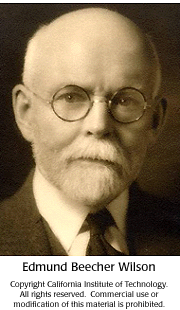Concept 9 Specialized chromosomes determine sex.

 Nettie Maria Stevens and Edmund Beecher Wilson both independently developed the idea of sex determination by chromosomes. Their work established the importance of chromosomes in heredity and helped Thomas Hunt Morgan interpret the early genetic results from Drosophila.
Nettie Maria Stevens and Edmund Beecher Wilson both independently developed the idea of sex determination by chromosomes. Their work established the importance of chromosomes in heredity and helped Thomas Hunt Morgan interpret the early genetic results from Drosophila.
Edmund Beecher Wilson (1856-1939)

Edmund Beecher Wilson was born in Geneva, Illinois. He was the son of a judge, but instead of law, Wilson chose to study biology at Yale University (1878). He did graduate work at Johns Hopkins University (1878-81). Wilson's training was in the field of embryology; genetics as a science did not exist at the time. Between the years of 1885-1891, Wilson was a professor at Bryn Mawr College and taught biological sciences; he also traveled to Europe to continue his own investigations. Cytology, the study of chromosomes, was becoming more important. Wilson soon became an expert, and began investigating the role of heredity in cellular development.
In 1891, Wilson left Bryn Mawr to become a professor at the zoology department at Columbia University. He eventually became head of the zoology department. Wilson continued to have ties with Bryn Mawr. He was good friends with Thomas Hunt Morgan who taught there, and Wilson continued to help and advise students of Bryn Mawr.
In 1904, Wilson invited Thomas Hunt Morgan to join the staff at Columbia, thereby helping to create the scientific atmosphere necessary for the interaction of cytology and genetics. In 1905, Wilson published a paper Studies on Chromosomes based on his studies of insect chromosomes. In this paper, Wilson advanced the theory of sex determination by chromosomes. In the same year, Wilson was asked to review Nettie Stevens' paper on the subject. Technically, Wilson's paper was already in press when he read Stevens' work (he heartily endorsed its publication). However, both Wilson and Stevens are credited with the theory of sex determination by chromosomes, since they arrived at it independently. Both Wilson and Stevens ended up referencing each other in their papers to support their conclusions.
Wilson published a series of Studies on Chromosomes papers. He also published books on cellular structure and general biology.
Wilson was a professional caliber cellist. He enjoyed sailing and would often invite Thomas Hunt Morgan and his family onto his boat. Herman Muller, one of Wilson's students, described him as a kind, scrupulous, careful man who was aware that ideas were useful only when communicated properly. Wilson's lectures were said to be organized, well-thought out and well-delivered. Wilson retired from Columbia in the early 1930's.


To prove the fertilizing power of semen (which contain sperm), in 1784, scientists put pants on male frogs before allowing them to mate. It was noted that the resulting eggs never developed.

Why have a reduction system for meiosis? Why not just "destroy" one set of chromosomes to produce sex cells?
 Children resemble their parents.
Children resemble their parents. Genes come in pairs.
Genes come in pairs. Genes don't blend.
Genes don't blend. Some genes are dominant.
Some genes are dominant. Genetic inheritance follows rules.
Genetic inheritance follows rules. Genes are real things.
Genes are real things. All cells arise from pre-existing cells.
All cells arise from pre-existing cells. Sex cells have one set of chromosomes; body cells have two.
Sex cells have one set of chromosomes; body cells have two. Specialized chromosomes determine sex.
Specialized chromosomes determine sex. Chromosomes carry genes.
Chromosomes carry genes. Genes get shuffled when chromosomes exchange pieces.
Genes get shuffled when chromosomes exchange pieces. Evolution begins with the inheritance of gene variations.
Evolution begins with the inheritance of gene variations. Mendelian laws apply to human beings.
Mendelian laws apply to human beings. Mendelian genetics cannot fully explain human health and behavior.
Mendelian genetics cannot fully explain human health and behavior.